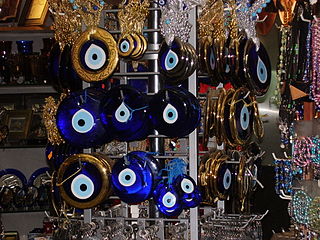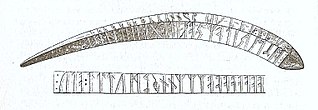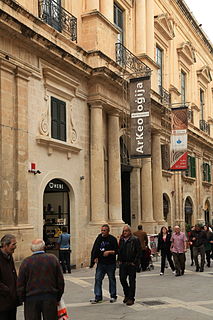
Crepundia are groups of amulets, often strung onto chains in Classical antiquity. [1] [2] They are similar to charm bracelets and are archaeologically associated with children. [3]

Crepundia are groups of amulets, often strung onto chains in Classical antiquity. [1] [2] They are similar to charm bracelets and are archaeologically associated with children. [3]
The singular form of the word, crepundium, derives from the Latin word crepare "to rattle or make a noise". The word crepundia may be confused with crepitacula, which refers to a form of rattle. Ancient examples may be made from ceramic, wood, or bronze. [4]
Similar amulet chains were used in the ancient world from at least the 4th Century BC. [5] Crepundia are referred to in Act 4 of Rudens (dated to c.211 BC) in which the character Palaestra describes the contents of a trinket box owned since childhood: a miniature gold sword inscribed with her father's name; a miniature gold axe inscribed with her mother's name; a silver knife; a little pig; a gold bulla . Crepundia are variable objects, but Martin-Kilcher defined five main sorts of objects that feature in them: noise-producing objects; meaningful shapes; those with ‘exterior qualities’; remarkable objects and curiosities; materials valued for their special properties. [3]
The noise-making components of crepundia may have been used to calm distressed infants or children, or used as a toy. [2]

The ankh or key of life is an ancient Egyptian hieroglyphic symbol used in Egyptian art and writing to represent the word for "life" and, by extension, as a symbol of life itself.

The evil eye is a supernatural belief in curse, brought about by a malevolent glare, usually given to a person when one is unaware. It dates back at least to Greek classical antiquity, 6th century BC where it appeared on Chalcidian drinking vessels, known as 'eye-cups', as a type of apotropaic magic. It is found in many cultures in the Mediterranean region, with such cultures often believing that receiving the evil eye will cause misfortune or injury, while others believe it to be a kind of supernatural force that casts or reflects a malevolent gaze back-upon those who wish harm upon others. Older iterations of the symbol were often made of ceramic or clay; however, following the production of glass beads in the Mediterranean region in approximately 1500 BC, evil eye beads were popularised with the Phoenicians, Persians, Greeks, Romans and Ottomans. Blue was likely used as it was relatively easy to create; however, modern evil eyes can be a range of colors.

The Bell Beaker culture is an archaeological culture named after the inverted-bell beaker drinking vessel used at the very beginning of the European Bronze Age. Arising from around 2800 BC, it lasted in Britain until as late as 1800 BC but in continental Europe only until 2300 BC, when it was succeeded by the Unetice culture. The culture was widely dispersed throughout Western Europe, from various regions in Iberia and spots facing northern Africa to the Danubian plains, the islands of Great Britain and Ireland, and also the islands of Sicily and Sardinia. The Bell Beaker phenomenon shows substantial regional variation, and a study from 2018 found that it was associated with genetically diverse populations, with the sampled individuals outside of Iberia and Sicily characterised by significant levels of Pontic-Caspian steppe-related ancestry.

The Urnfield culture was a late Bronze Age culture of Central Europe, often divided into several local cultures within a broader Urnfield tradition. The name comes from the custom of cremating the dead and placing their ashes in urns which were then buried in fields. Over much of Europe, the Urnfield culture followed the Tumulus culture and was succeeded by the Hallstatt culture. Some linguists and archaeologists have associated this culture with the Proto-Celtic language, or a pre-Celtic language family.
In the Hebrew Bible, Tophet or Topheth is a location in Jerusalem in the Valley of Hinnom (Gehenna), where worshipers engaged in a ritual involving "passing a child through the fire", most likely child sacrifice. Traditionally, the sacrifices have been ascribed to a god named Moloch. The Bible condemns and forbids these sacrifices, and the tophet is eventually destroyed by king Josiah, although mentions by the prophets Jeremiah, Ezekiel, and Isaiah suggest that the practices associated with the tophet may have persisted.

The Nordic Bronze Age is a period of Scandinavian prehistory from c. 1750–500 BC.

Archaic Greece was the period in Greek history lasting from circa 800 BC to the second Persian invasion of Greece in 480 BC, following the Greek Dark Ages and succeeded by the Classical period. In the archaic period, Greeks settled across the Mediterranean and the Black Seas, as far as Marseille in the west and Trapezus (Trebizond) in the east; and by the end of the archaic period, they were part of a trade network that spanned the entire Mediterranean.

Vetulonia, formerly called Vetulonium, was an ancient town of Etruria, Italy, the site of which is probably occupied by the modern village of Vetulonia, which up to 1887 bore the name of Colonnata and Colonna di Buriano: the site is currently a frazione of the comune of Castiglione della Pescaia, with some 400 inhabitants.
A runic inscription is an inscription made in one of the various runic alphabets. They generally contained practical information or memorials instead of magic or mythic stories. The body of runic inscriptions falls into the three categories of Elder Futhark, Anglo-Frisian Futhorc and Younger Futhark.

The Lindholm "amulet", listed as DR 261 in Rundata, is a bone piece, carved into the shape of a rib, dated to the 2nd to 4th centuries and has a runic inscription. The Lindholm bone piece is dated between 375CE to 570CE and it is around 17 centimeters long at its longest points. It currently resides at Lund University Historical Museum in Sweden.

The prehistory of Ireland has been pieced together from archaeological evidence, which has grown at an increasing rate over the last decades. It begins with the first evidence of permanent human residence in Ireland around 10,500 BC and finishes with the start of the historical record around 400 AD. Both the beginning and end dates of the period are later than for much of Europe and all of the Near East. The prehistoric period covers the Palaeolithic, Mesolithic, Neolithic, Bronze Age and Iron Age societies of Ireland. For much of Europe, the historical record begins when the Romans invaded; as Ireland was not invaded by the Romans its historical record starts later, with the coming of Christianity.

Minoan religion was the religion of the Bronze Age Minoan civilization of Crete. In the absence of readable texts from most of the period, modern scholars have reconstructed it almost totally on the basis of archaeological evidence of such as Minoan paintings, statuettes, vessels for rituals and seals and rings. Minoan religion is considered to have been closely related to Near Eastern ancient religions, and its central deity is generally agreed to have been a goddess, although a number of deities are now generally thought to have been worshipped. Prominent Minoan sacred symbols include the bull and the horns of consecration, the labrys double-headed axe, and possibly the serpent.

In ancient Roman religion and magic, the fascinus or fascinum was the embodiment of the divine phallus. The word can refer to phallus effigies and amulets, and to the spells used to invoke his divine protection. Pliny calls it a medicus invidiae, a "doctor" or remedy for envy or the evil eye.

An amulet, also known as a good luck charm, is an object believed to confer protection upon its possessor. The word "amulet" comes from the Latin word amuletum, which Pliny's Natural History describes as "an object that protects a person from trouble". Anything can function as an amulet; items commonly so used include gems, statues, coins, drawings, plant parts, animal parts, and written words.

The National Museum of Archaeology is a Maltese museum in Valletta, with artefacts from prehistory, Phoenician times and a notable numismatic collection. It is managed by Heritage Malta.

Dartmoor kistvaens are burial tombs or cists from the late Neolithic and early Bronze Age, i.e. from c 2500 BC to c 1500 BC. Kistvaens have been found in many places, including Dartmoor, a 954 km2 area of moorland in south Devon, England. The box-like stone tombs were created when the ancient people of the area lived in hut circles. Cists are often to be found in the centre of a cairn circle although some appear solitary which could be the result of the loss of an original slight mound. There are over 180 known cists on Dartmoor although there could be up to 100 that remain buried underneath unexplored cairns. In the South West there are no cists to be found on the Quantock Hills, only 2 to be found on Exmoor and 58 to be found on Bodmin Moor. The Dartmoor cists are unique in that about 94% have the longer axis of the tomb orientated in a NW/SE direction It appears that Dartmoor cists were positioned in such a way that the deceased were facing the sun.

Anglo-Saxon Amulets and Curing Stones is an archaeological study of amulets, talismans and curing stones in the burial record of Anglo-Saxon England. Written by the Australian archaeologist Audrey Meaney, it was published by the company British Archaeological Reports as the 96th monograph in their BAR British Series. Prior to writing the work, Meaney had published several books dealing with Anglo-Saxon burials.

A baby rattle is a rattle produced specifically for the amusement of an infant. Rattles have been used for this purpose since antiquity, and experts in child development believe they help the infant improve hand eye coordination by stimulating their senses.
Véronique Dasen is a Swiss archaeologist and Professor in Classical Archaeology and Art History at the University of Fribourg. Her research is led in a multidisciplinary and anthropological perspective. Her research interests range from ancient iconography and material culture, the history of the body, of medicine and magical practices to gender studies, history of childhood, and ludic culture.
Nina Crummy is a British archaeologist and artefact specialist, especially of Roman material culture.